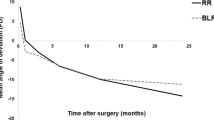Abstract
Background
To investigate the incidence of and factors predisposing to consecutive esotropia after intermittent exotropia surgery, and to prevent the onset of consecutive esotropia.
Methods
We retrospectively surveyed 226 patients who had been followed up for more than 1 year after surgery for intermittent exotropia conducted between February 2005 and September 2010. Consecutive esotropia was defined as an esotropia of at least 10 prism diopters (PD) at distance or near at least once in 2 weeks after surgery. Presumed risk factors for consecutive esotropia were analyzed. Gender, age at surgery, average binocular spherical equivalent, anisometropia, high myopia, amblyopia, preoperative angle of deviation, vertical deviation, A-V pattern strabismus, exotropia type, type of surgery, stereopsis, and suppression were investigated to evaluate factors influencing the onset of consecutive esotropia.
Results
Consecutive esotropia occurred in 22 patients (9.7 %). Significant correlations with occurrence of the condition were found with high myopia (P = 0.013), amblyopia (P = 0.047), preoperative angle of deviation of 25–40 PD at distance (P = 0.016), deviation at distance – deviation at near > 10 PD (P = 0.041), lateral incomitance (P = 0.007), tenacious proximal convergence fusion type (P = 0.001), unilateral lateral rectus muscle recession and medial rectus muscle resection (P = 0.001).
Conclusions
High myopia, amblyopia, and lateral incomitance were predisposing factors for consecutive esotropia. Furthermore, the preoperative angle of deviation at distance, differences between the angle of deviation at near and at distance, the type of intermittent exotropia, and the type of surgery affected the incidence of consecutive esotropia. More attention must be paid to patients with such factors.
Similar content being viewed by others
References
Hardesty HH, Boynton JR, Keenan IP (1978) Treatment of intermittent exotropia. Arch Ophthalmol 96:268–274
Burian HM, Spivey BE (1965) The surgical management of exodeviation. Am J Ophthalmol 59:603–620
Fletcher MC, Silverman SJ (1966) Strabismus. Part 1. A summary of 1110 consecutive cases. Am J Ophthalmol 61:86–94
Edelman PM, Brown MH, Murphee AL, Wright KW (1988) Consecutive esodeviation, then what? Am Orthopt J 38:111–116
Richard JM, Parks MM (1983) Intermittent exotropia surgical results in different age groups. Ophthalmology 90:1172–1177
Raab SD, Parks MM (1969) Recession of the lateral recti. Early and late postoperative alignments. Arch Ophthalmol 82:203–208
Ruttum MS (1997) Initial versus subsequent postoperative motor alignment in intermittent exotropia. J AAPOS 1:88–91
Keech RV, Stewart SA (1990) The surgical overcorrection of intermittent exotropia. J Pediatr Ophthalmol Strabismus 27:218–220
Kim HS, Suh YW, Kim SH, Cho YA (2007) Consecutive esotropia in intermittent exotropia patients with immediate postoperative overcorrection more than 17 prism diopters. Korean J Ophthalmol 21:155–158
Knapp P (1971) Management of exotropia. In: Symposium on strabismus: transactions of the New Orleans Academy of Ophthalmology. Mosby, St. Louis
Scheiman M, Wick B (2008) Clinical management of binocular vision. Lippincott Williams & Wilkins, Philadelphia, Chap, Chap. 10
Parks MM (1990) Comitant exodeviations. In: Duane TD (ed) Clinical ophthalmology, vol 1. Harper Row, Philadelphia, Chap. 13
Carlos SD, Carlos FU (1993) Postoperative evaluation of the planned initial overcorrection in intermittent exotropia: 61 cases. Binocular Vision Eye Muscle Surg 8:141–148
Dunlap EA (1971) Overcorrections in exotropia surgery. In: Manley DR (ed) Symposium on horizontal ocular deviations. Mosby., St. Louis, p 183
Knapp P (1958) Divergent deviations. In: Allen JH (ed) Strabismic ophthalmic symposium II. Mosby, St. Louis, p 354
Pratt-Johnson JA, Barlow JM, Tilson G (1977) Early surgery in intermittent exotropia. Am J Ophthalmol 84:689–694
Clacke WN, Noel LP (1981) Surgical results in intermittent exotropia. Can J Ophthalmol 16:66–69
Jampolsky A (1962) Management of exodeviation. In: Haik GM (ed) Strabismus symposium of the New Orleans Academy of Ophthalmology. Mosby, St. Louis, pp 140–156
Scattergood KD, Brown MH, Guyton DL (1983) Artifacts introduced by spectacles lenses in the measurement of strabismic deviation. Am J Ophthalmol 96:439
Moore S (1969) The prognostic value of lateral gaze measurements in intermittent exotropia. Am Orthopt J 19:69–71
Parks MM (1962) Strabismus symposium of the New Orleans Academy of Ophthalmology. Mosby, St. Louis, pp 31–55
Kushner BJ, Morton GV (1998) Distance/Near differences in intermittent exotropia. Arch Ophthalmol 116:478–486
Beneish R, Flanders M (1994) The role of strabismus and early postoperative alignment in long-term surgical results in intermittent exotropia. Can J Ophthalmol 29:119–124
Gill MK, Drummond GT (1997) Indications and outcomes of strabismus repair in visually mature patients. Can J Ophthalmol 32:436–440
Frederick JE (1992) Consecutive esotropia. Am Orthoptic J 42:94–97
None of the authors have a financial interest related to the article.
Author information
Authors and Affiliations
Corresponding author
Rights and permissions
About this article
Cite this article
Jang, J.H., Park, J.M. & Lee, S.J. Factors predisposing to consecutive esotropia after surgery to correct intermittent exotropia. Graefes Arch Clin Exp Ophthalmol 250, 1485–1490 (2012). https://doi.org/10.1007/s00417-012-1991-y
Received:
Revised:
Accepted:
Published:
Issue Date:
DOI: https://doi.org/10.1007/s00417-012-1991-y




